
Construct validity is a critical measurement concept in research methodology that assesses the quality of how the theoretical construct is evaluated. It analyzes whether the scores or outcomes from a measurement tool behave the way they should, based on existing theories or constructs. Essentially, it aims to ensure that the method of measurement aligns with the theoretical relationship between variables. Ultimately, it is vital, as it reflects on the overall reliability and validity of a study.
Definition: Construct validity
Construct validity is a means of testing the validity of a research method or test. It demonstrates that the research method or test actually measures the concept it claims to measure. Measuring construct validity helps researchers establish the validity or a method.
Besides construct validity, three other types of measurement validity exist. These are:
- Content validity
- Face validity
- Criterion validity
The “construct” in construct validity
A construct is a hypothetical notion or idea founded on pragmatic observations. In simpler terms, it is a variable that you cannot measure or observe directly.
The above constructs are impossible to observe and measure using regular research methods.
There are two types of constructs: simple and complex.
Simple consctruct
For instance, a concept like dominant hand is a simple construct because you can assess it through:
- Basic survey questions like asking research subjects to identify their dominant hand
- Simple observations like asking subjects to perform specific tasks and observing the hand they use
Complex construct
Concepts like depression, intelligence, and anxiety are complex constructs. Therefore, they require complex measurements like medical consultations and psychometric surveys.
The construct validity
Construct validity is about the extent to which a research method or measure can accurately assess the concept it aims to measure. Researchers usually operationalize paradigms depending on their dimensions and notion. You can split constructs into quantifiable and concrete qualities. It would be wise to do this before gathering and examining data as it helps you determine the right research methods to use. Additionally, defining constructs helps you avoid research biases and mistakes.
When designing the research measure, you must consider whether it targets your construct or assesses related constructs. Therefore, differentiating your construct from similar ones is a crucial part of making sure that your measure focuses on the right thing.
The two types of construct validity
There are two primary types of construct validity. They are:
Convergent validity
Convergent validity refers to the degree to which measures of alike notions relate to one another.
Discriminant validity
Discriminant validity implies that measures testing different or opposite constructs should be unrelated, weakly related, or adversely related. Researchers assess discriminant validity by comparing the results of various measures or determining their correlation. You can select unrelated constructs by selecting the ones that are theoretically opposite or distinct in the same category, like introversion and extroversion. You can also pick non-opposing notions and determine that they have no relationship or a weak relationship.
Measuring construct validity
You can measure construct validity after establishing a new measure. So, you can test the new measure using:
- A trial run or a pilot study using a small sample to test the validity, viability, and dependability.
- Statistical analyses conducted on data from the measures.
- Regression analyses to test if the measure can predict the outcome you expect it to predict.
in Your Thesis
Obstacles to construct validity
Some common threats can hinder construct validity. They include:
Bad operationalization
This is a significant threat to construct validity. You need a proper operational definition of a notion so you can measure it accurately and precisely. Therefore, lack of a proper operational definition may trigger random or systematic errors.
Expectations of the experimenter
Expectations from the researcher may lead to research bias. You can combat this issue by involving others that do not know the hypothesis or have any expectations.
Subject bias
Expectations from the participants may influence their responses, which prevent you from accurate measurements. You can avoid this issue by hiding the true agenda or purpose of the study from the subjects.
FAQs
Construct validity is about how accurately or well a research test measures the notion for which it is designed to test.
It helps researchers ensure that they are measuring the right construct. It also helps with choosing the right research methods.
It is important when dealing with constructs that you cannot measure. It also comes in handy for concepts you cannot observe directly.
There are two types of construct validity. They are; convergent and discriminant construct validity.
